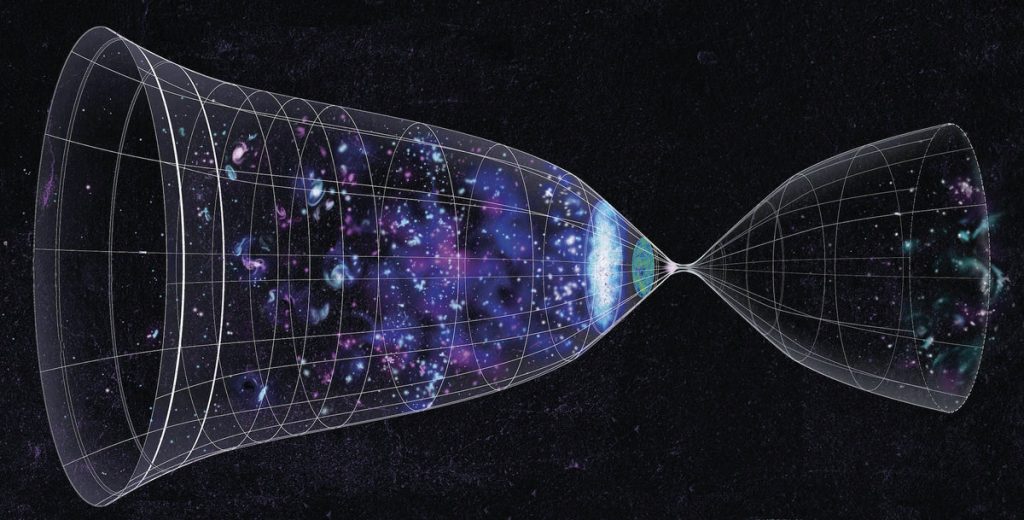The Ekpyrotic Universe is a cosmological framework proposed in 2001 by Justin Khoury, Burt A. Ovrut, Paul J. Steinhardt, and Neil Turok in which the hot big bang arises from the collision of branes in a higher-dimensional bulk, with the pre–big bang epoch characterized by slow contraction driven by an ultra–stiff equation of state. The original formulation was embedded in heterotic M‑theory (Hořava–Witten) brane constructions. The Ekpyrotic Universe: Colliding Branes and the Origin of the Hot Big Bang;
Phys. Rev. D 64, 123522.
Framework and dynamics
In ekpyrotic cosmology, the universe undergoes a smoothing phase of slow contraction with effective equation of state parameter w ≫ 1, which suppresses spatial curvature and anisotropies and thereby addresses the flatness and horizon problems without invoking an early phase of accelerated expansion as in [Inflation (cosmology)]. The suppression of mixmaster/BKL–type chaotic behavior by a stiff contracting scalar field was analyzed in detail, showing that anisotropies are dynamically damped when w > 1. Phys. Rev. D 69, 063514.
The pre–big bang phase culminates in a brane collision that initiates the hot, expanding epoch associated with the Big Bang. In the original ekpyrotic scenario this collision was modeled using moduli dynamics in a 5D brane setup motivated by heterotic M‑theory, providing a geometric interpretation of the bang as an inter‑brane event. The Ekpyrotic Universe: Colliding Branes and the Origin of the Hot Big Bang;
Phys. Rev. D 65, 126003.
Generation of cosmological perturbations
Early single‑field ekpyrotic models were shown to yield a strongly blue and suppressed adiabatic curvature spectrum during contraction once gravitational backreaction is treated consistently, necessitating alternative mechanisms for producing the observed nearly scale‑invariant density perturbations. The primordial curvature perturbation in the ekpyrotic Universe;
Density Perturbations in the Ekpyrotic Scenario.
A two‑field “entropic mechanism” was subsequently developed: nearly scale‑invariant entropy perturbations generated during ekpyrosis are converted into curvature perturbations either before or after the bounce, enabling agreement with observations while retaining the contracting background. Representative analyses derive the amplitude, tilt, and non‑Gaussian signatures expected from this conversion. Phys. Rev. D 76, 103501;
Phys. Rev. D 77, 063533;
Ekpyrotic and Cyclic Cosmology.
Tensor perturbations in ekpyrotic models are predicted to have very small amplitude on observable scales, often with a blue spectrum, implying an undetectably small primordial tensor‑to‑scalar ratio r for CMB B‑mode experiments. The Ekpyrotic Universe: Colliding Branes and the Origin of the Hot Big Bang;
Ekpyrotic and Cyclic Cosmology.
Bounce and model building
The transition from contraction to expansion can be treated as a singular bounce (brane collision) or as a nonsingular bounce achieved within effective field theory. “New ekpyrotic” constructions combine ekpyrosis with a ghost‑condensate or related NEC‑violating sector to produce a smooth bounce while keeping perturbations under control; these models generically maintain negligible primordial tensors and can accommodate a slightly red scalar tilt. Phys. Rev. D 76, 123503;
New ekpyrotic cosmology (OSTI record);
Ekpyrotic and Cyclic Cosmology.
Matching conditions for perturbations across the bounce were the subject of debate in the early literature, with critiques arguing that some proposed prescriptions were not justified; these discussions helped motivate the development of multi‑field entropic mechanisms and nonsingular bounces. The failure of cosmological perturbation theory in the new ekpyrotic and cyclic ekpyrotic scenarios;
Generating ekpyrotic curvature perturbations before the big bang.
Relation to cyclic cosmology
The ekpyrotic phase is a key ingredient of cyclic models in which the universe experiences repeated sequences of expansion, accelerated expansion, contraction, and bounce, with dark energy playing a role in resetting conditions for the next cycle. A seminal proposal outlined the cyclic picture and its cosmic history, building on the ekpyrotic framework. Science 296, 1436 (2002);
Phys. Rev. D 65, 126003;
Dark Energy and the Return of the Phoenix Universe.
Observational status
- –Scalar power spectrum: CMB observations favor a nearly scale‑invariant, slightly red spectrum with n_s ≈ 0.965; ekpyrotic models using the entropic mechanism can reproduce such tilts.
Astron. Astrophys. 641, A6 (2020).
- –Primordial tensors: Current leading CMB polarization constraints from BICEP/Keck using data through 2018 set r_{0.05} < 0.036 (95% C.L.), consistent with the ekpyrotic expectation of undetectable tensors.
BICEP/Keck BK18 (arXiv:2110.00483) summary;
Constraining Inflation with the BICEP/Keck CMB Polarization Experiments (2024).
- –Primordial non‑Gaussianity: Planck’s final bispectrum analysis yields f_NL^{local} = −0.9 ± 5.1 (68% C.L.), strongly limiting models that predict large local‑type non‑Gaussianity; ekpyrotic scenarios with gentle entropic conversion can satisfy these bounds.
Astron. Astrophys. 641, A9 (2020);
Non‑Gaussian density fluctuations from entropically generated curvature perturbations in ekpyrotic models.
Criticisms and open issues
Shortly after the original proposal, critiques highlighted model‑building challenges in the heterotic M‑theory embedding (brane tension assignments, required potential shapes, and sensitivity to initial conditions). These issues, alongside questions about matching conditions, spurred the shift to two‑field and nonsingular‑bounce implementations. Pyrotechnic Universe;
Pyrotechnic universe, Phys. Rev. D 64, 123523;
A Brief Comment on "The Pyrotechnic Universe".
Terminology and historical note
The term “ekpyrotic” alludes to ekpyrosis in ancient Stoic cosmology, the idea of a periodic cosmic conflagration and renewal; more generally, Stoic physics included belief in recurrent world conflagrations. Stoicism — Ancient Stoicism (Britannica).
Connections and context
The ekpyrotic program contrasts with inflationary approaches, yet both seek to explain the observed statistics of the Cosmic microwave background and large‑scale structure. Its higher‑dimensional setting relates it to String Theory, M-theory, and Brane cosmology, while empirical tests involve CMB missions such as [Planck (spacecraft)] and ground‑based B‑mode experiments including BICEP2. Astron. Astrophys. 641, A9 (2020);
BICEP/Keck BK18 (arXiv:2110.00483) summary.
